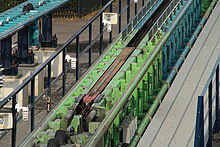Launched coaster
As Launched Coaster (dt. Catapult roller coaster or launching roller coaster) refers to a roller coaster , wherein the train is not a hill ( lifthill is transported up) and then by potential energy to accelerate, but is accelerated catapult-like on a generally straight route.
There are different types of drive for the "launch". Common both flywheels -, pneumatic - and hydraulic actuators, and electrical traction systems, the latter (such as magnetic levitation trains) on the principle of linear motor based. With most drives, a driver attached to a rotating steel cable (also called a catch car or caddy) is hooked onto the roller coaster train. The pulleys over which the rope runs are driven, thus accelerating the train. At the end of the acceleration section, the caddy automatically disengages from the train. The driver is braked and then pulled back into the starting position.
In addition to the type name Launched Coaster, there are various manufacturer-specific type designations. Intamin names its courses, for example, Accelerator Coaster .
Flywheels

The first catapult roller coasters were developed by Anton Schwarzkopf in 1976 . The early models of the Shuttle Loop used a weight that was dropped to accelerate the train. In later systems, a flywheel weighing tons is accelerated by a motor. At the start, the energy stored in the disc is transferred to a steel cable and thus to the caddy via a slip clutch .
Pneumatics
A cylinder through which the steel cable also runs runs alongside the pneumatically driven track . A slide in the cylinder is attached to the steel cable opposite the caddy. A sudden increase in pressure on one side of the slide moves it in the opposite direction, thus driving the train.
- Examples:
- Dodonpa in Fuji-Q Highland (Japan) from S&S Power Inc.
- ring ° racer in the ring ° factory at the Nürburgring (Germany) from S&S Power Inc.
Hydraulics
Modern launched coasters usually use a system of hydraulic motors as drive. Hydraulic fluid is pumped into storage tanks here. In further pressure vessels, nitrogen is strongly compressed, the necessary energy can be stored relatively slowly and evenly. When starting, the compressed gas pushes the hydraulic oil out of the reservoir through lines onto the hydraulic motors arranged in a circle. In this way, the entire amount of energy can be transferred very quickly to a central shaft, which then drives the steel cable. In the world record roller coaster Formula Rossa at Ferrari World Abu Dhabi, the train with such a drive reaches a speed of 240 km / h within 4.9 seconds.
- Examples:
- Booster Bike in Toverland (Netherlands) from Vekoma
- Desert Race in Heide-Park Soltau (Germany) by Intamin AG Switzerland
- Formula Rossa in Ferrari World (UAE) from Intamin AG Switzerland
- Kingda Ka in Six Flags Great Adventure (USA) by Intamin AG Switzerland
LIM / LSM
The abbreviation stands for LIM " L inearer I nduktions m otor" or LSM for " L inearer S ynchron m otor". The way it works is similar to that of a rotating electric motor, with the difference that the electromagnets are not housed round in a cylinder, but are flat. In contrast to the other drives, here no caddy is accelerated on a steel cable, but either the train or a driver is driven directly.
- Examples for LSM:
- Blue Fire Megacoaster in Europa-Park (Germany) by Mack Rides
- Curse of Novgorod in Hansa-Park (Germany) by Gerstlauer Amusement Rides , which also has a 90 ° chain lift
- Formule X in the Drievliet Family Park (Netherlands) by Maurer Söhne
- Star Trek: Operation Enterprise at Movie Park Germany (Germany) by Mack Rides
- Taron in Phantasialand (Germany) by Intamin
- Xpress in Walibi Holland (The Netherlands) by Vekoma
- Full Throttle in Six Flags Magic Mountain (USA) by Premier RIdes
- Karacho in the adventure park Tripsdrill (Germany) by Gerstlauer Amusement Rides
- Examples for LIM:
- California Screamin ' in Disney's California Adventure (USA) by Intamin AG Switzerland
- Wicked Twister at Cedar Point (USA) from Intamin AG Switzerland
Friction wheels
Few roller coasters use a stretch of increasingly faster running friction wheels to launch them.
- Examples:
Individual evidence
- ↑ Record holder. rcdb.com


